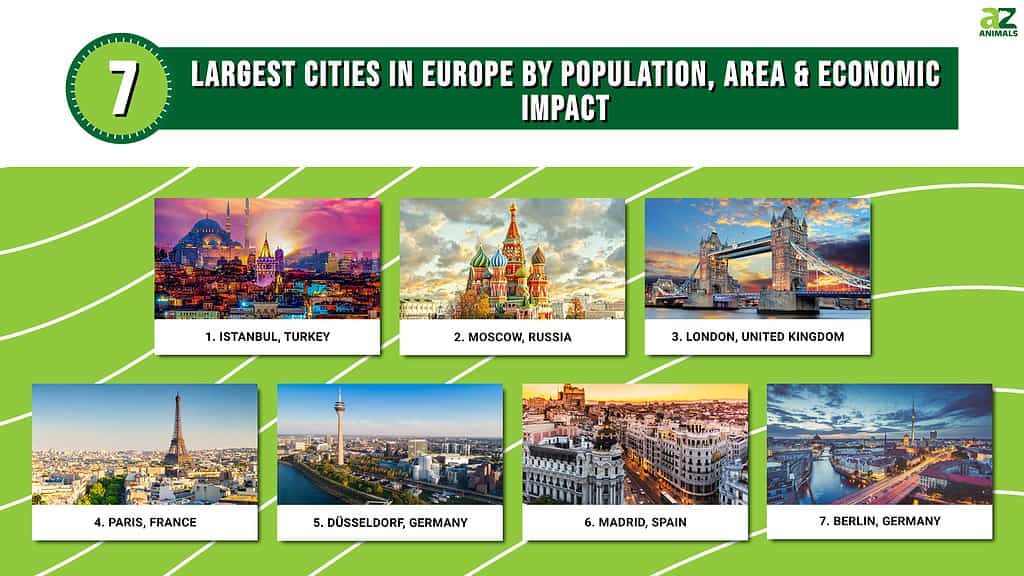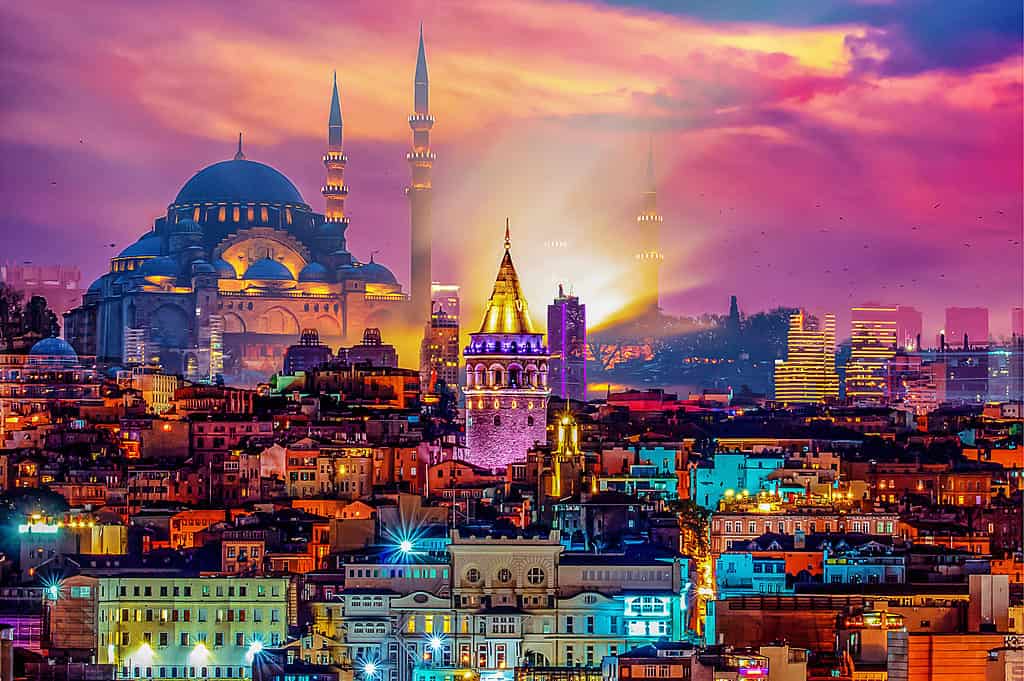Europe is one of the continents that shows the earliest signs of human activity in the entire world. The first fossils indicating human life were thought to have existed some 48,000 years ago. Ever since human life began in Europe, the continent has been a hub of developing civilizations, empires, innovation, and culture.
Large cities in Europe include
Europe was home to one of the world’s first extremely advanced civilizations, the ancient Greeks. Apart from establishing the inner workings of modern society, the Greeks created many useful inventions and practices that we still rely on today.
However, even the Greeks were not immune to the test of time. The Roman Empire overthrew the Greeks in 146 BC and remained in power for around 1,000 years. While ruthless, this civilization furthered modern thinking and innovation greatly, establishing Europe as a major influence on the rest of the world.
Today, Europe is known for its rich history, diverse cultures, and immense impact. While large empires no longer control the continent, many cities in Europe continue to grow and evolve with time. The many different countries in the continent offer a wide array of differing landscapes, opportunities, and lifestyles. Keep reading to discover the seven largest cities in Europe ranked by population, total area, and economic impact.

Largest Cities in Europe by Population

As of December 2022, Istanbul was home to 15,907,951 residents, making it the largest city in Europe by population and the 15th most populous city in the world.
©Travel Turkey/Shutterstock.com
Within the European continent, there are over 800 cities. However, many of these are more like small towns than bustling metropolises. While most of Europe is filled with smaller towns, there are a few cities that house significantly more residents than the rest. Here are the largest cities in Europe by population.
1. Istanbul, Turkey
Located on the southeastern edge of the continent, Turkey bridges the gap between Europe and the Middle East. Although Ankara is the capital of Turkey, Istanbul has a larger population by far. As of December 2022, Istanbul was home to 15,907,951 residents, making it the largest city in Europe by population and the 15th most populous city in the world. While Istanbul encompasses an impressive 594 square miles, it is still extremely crowded. The city has an urban population density of 15,650 residents per square mile and a metropolitan density of 2,063 residents per square mile. Istanbul is a popular destination made famous by its historical palaces, churches, and mosques.
2. Moscow, Russia
Moscow is both the capital of Russia and the country’s most populous city. Located towards the western side of the massive country, Moscow houses the Russian government and millions of residents. There are 104,177 people living within the city limits. With a total area of 2,376 square miles, Moscow has a population density of around 8,537 residents per square mile. That is extremely crowded! Aside from its impressive population, Moscow is considered the cultural hub of Russia. The city has been home to many important political figures, artists, and athletes over its extensive history.
3. London, United Kingdom
The third largest city by population in Europe is London. While the United Kingdom is a part of Europe, it is located on a large island off of the continent’s eastern shore. However, London provides a busy metropolitan lifestyle rather than a typical island dwelling. As of March 2021, the city was home to 8,799,800 residents. London encompasses 671 square miles, meaning that it has a population density of 13,114 residents per square mile. The historical city is a wonderful place to visit and is home to the royal family and British Parliament.
Review: Largest Cities in Europe by Population
| City | Country | Population | Population Density (Residents per Square Mile) |
|---|---|---|---|
| Istanbul | Turkey | 15,907,951 | 15,650 (urban) 2,063 (metropolitan) |
| Moscow | Russia | 13,104,177 | 8,537 |
| London | United Kingdom | 8,799,800 | 13,114 |
Largest Cities in Europe by Total Area

Moscow’s expansive 2,376 square miles of urban area is almost unfathomably large.
©Reidl/Shutterstock.com
While population and land mass often correlate, the largest cities in Europe by total area slightly differ. A larger area with fewer residents means that some of these places are less crowded and packed, which many people prefer. Here are the largest cities in Europe by total area.
1. Moscow, Russia
The second-largest city in Europe by population is also the largest in Europe by total area. Moscow’s expansive 2,376 square miles of urban area is almost unfathomably large. For example, all of New York City could fit into Moscow three times, and there would still be room left! Moscow sits on the Moscow River in the center of a very large plain. This means that the landscape of the city is relatively flat, without many hills or varying elevations. The city has a humid continental climate, meaning Moscow experiences warm summers and extremely cold winters.
2. Paris, France
Although Paris does not have one of the three largest populations in Europe, it is the second-largest by total area. The total urban area of Paris encompasses 1,102 square miles. Paris is also the capital of France and is located in the northern region of the country. While the urban section of Paris is fairly flat, the area is surrounded by lush forests with varying elevations. However, the city is located on several waterways, which allowed it to become the commercial center of the country due to easy transportation access and water supply. Because of its location, Paris has a temperate climate with sharp winds.
3. Düsseldorf, Germany
With a total urban area of 1,036 square miles, Düsseldorf is just slightly smaller than Paris. Düsseldorf is located on the northwestern side of Germany in the middle of the Rhine Basin. This gives it proximity to the Rhine River on the eastern bank. Its location in a basin means that Düsseldorf has a fairly flat elevation and experiences mild winters and warm summers.
Review: Largest Cities in Europe by Total Area
| City | Country | Total Area (Square Miles) |
|---|---|---|
| Moscow | Russia | 2,376 |
| Paris | France | 1,102 |
| Düsseldorf | Germany | 1,036 |
Largest Cities in Europe by Economic Impact

In 2021, Paris reported a gross domestic product of a staggering 764.8 billion euros.
©iStock.com/Sean3810
The final statistic we will be examining European cities with is their economic impact. With a large population and land area, cities often have more capability to house many different industries and economic opportunities. Here are the largest cities in Europe by economic impact, determined by looking at their gross domestic product.
1. Paris, France
The second largest city by total area in Europe also has the largest economic impact on the continent. In 2021, Paris reported a gross domestic product of a staggering 764.8 billion euros. The largest sectors that contributed to this number are the manufacturing, cosmetic, and technological industries. On top of these fields, Paris also draws in an amazing 30,000,000 tourists each year.
2. Madrid, Spain
Although Madrid has the second-highest gross domestic product of any city in Europe, the number is still much smaller than Paris’. In 2021, the capital of Spain had a reported gross domestic product of around 235 billion euros. The main industry that contributes to this number is tourism, with an amazing 6,000,000 people flocking to the city annually. Other large sectors include finance and pharmaceuticals.
3. Berlin, Germany
Germany’s capital city, Berlin, has the third largest economic impact of any city in Europe. In 2021, the city had a reported gross domestic product of 205 billion euros. The main industries that contributed to this number are the sectors of transportation, media, and service.
Review: Largest Cities in Europe by Economic Impact
| City | Country | Gross Domestic Product (euros) |
|---|---|---|
| Paris | France | 764.8 billion |
| Madrid | Spain | 235 billion |
| Berlin | Germany | 205 billion |
Summary of the Largest Cities in Europe
| City | Country | Size | |
|---|---|---|---|
| 1. | Istanbul | Turkey | Population 15,907,951 |
| 2. | Moscow | Russia | Population 13,104,177 |
| 3. | London | England | Population 8,799,800 |
| 4. | Moscow | Russia | Total Area 2,376 sq miles |
| 5. | Paris | France | Total Area 1,102 sq miles |
| 6. | Düsseldorf | Germany | Total Area 1,036 sq miles |
| 7. | Paris | France | 764.8 billion GDP |
| 8. | Madrid | Spain | 235 billion GDP |
| 9. | Berlin | Germany | 205 billion GDP |
Thank you for reading! Have some feedback for us? Contact the AZ Animals editorial team.








